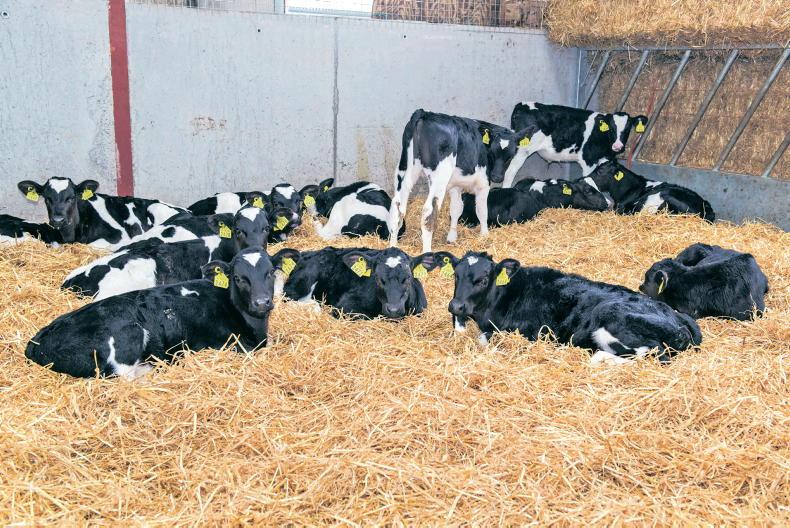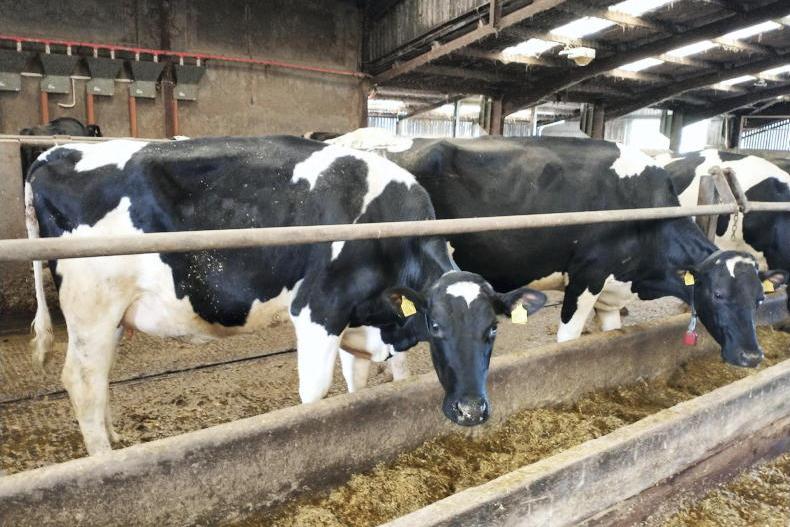Wetter weather – particularly in 2023 and 2024 – has seen an anecdotal increase in the incidence of liver and rumen fluke. The parasites thrive in wet conditions and so wet summers – and more so wet autumns – are a high risk for fluke. It’s important to distinguish between the two different types of fluke. Liver fluke affects the liver and it can be a serious health problem for all animals if any liver fluke is present.
Adult rumen fluke lives in the rumen or stomach of cattle with the immature larval living in the small intestine or gut of the animal.
It is the presence of these larvae at big numbers that cause the main animal health issues with rumen fluke.
Life cycle
The life cycle of rumen fluke has similarities with liver fluke in that it relies on an intermediate host for the parasite to re-infect cattle and sheep. This intermediate host is a mud snail that tends to live in heavy and wet soils, or near water courses and ponds.
The first stage of the life cycle is that the eggs which are present in the rumen of the animal are passed on to grass and pasture through the faeces. These eggs then hatch and infect the mud snail which acts as a host for the rumen fluke.
According to Animal Health Ireland, the larval rumen fluke develop through several stages in the snail until cercariae are released by the snail and encyst on grass as metacercariae. These metacercariae, or larvae, are what the animal will consume when it eats the infected grass and so it becomes the host for the rumen fluke.
The larval rumen fluke which are ingested by the animal on the grass make their way to the small intestine and damage the wall lining and causes scour and weight loss to the animal. Both cattle and sheep are susceptible.
After a number of weeks or months, the larvae in the small intestine migrate to the rumen and grow into adult rumen fluke where they multiply by laying eggs. It is these eggs that are released in faeces on to pasture and the cycle continues.
The signs of rumen fluke
In most cases, an outbreak of rumen fluke is a slow and gradual process, as opposed to a big-bang event. It’s important to note that many animals will have some presence of rumen fluke in their bodies without it causing any substantial harm. This is very different to liver fluke which can cause issues at all levels of infection.
Looking out for clinical signs of rumen fluke can be difficult as many of the symptoms overlap with symptoms of other diseases. Animal Health Ireland says that the following symptoms are associated with rumen fluke: dullness, dehydration, rapid weight loss, severe watery scour which may contain traces of blood, low blood protein concentrations and swelling under the jaw (which is also known as bottle-jaw). Left untreated, Animal Health Ireland says severely affected animals may die due to dehydration.
Where animals have died, post-mortems can be carried out and if rumen fluke is the cause, the rumen fluke larvae will be in evidence along the wall of the small intestine
As said, many of these symptoms are the same symptoms for other diseases so clinical diagnosis should be carried out before animals are treated. This is very important as the treatment for rumen fluke is very limited and if animals are treated unnecessarily then resistance is likely to develop.
In terms of diagnostic testing, taking faecal samples and getting them analysed for the presence of rumen fluke can confirm the presence of rumen fluke. This can be done through taking dung samples and getting these analysed by a lab. However, many samples will return positive diagnoses for rumen fluke without being a problem or requiring treatment. Essentially, the faecal tests can be used to confirm suspicions of rumen fluke, but dosing strategies shouldn’t rely entirely on faecal egg counts.
Where animals have died, post-mortems can be carried out and if rumen fluke is the cause, the rumen fluke larvae will be in evidence along the wall of the small intestine.
Treatment
There is only one active ingredient available which is effective against rumen fluke and this is oxyclozanide. As there is only one active ingredient, it is critical that it is used only in occasions where it is absolutely necessary as the build-up of resistance by the fluke to oxyclozanide would be very serious.
As a result, the advice is to only treat animals where absolutely necessary and rarely routinely dose for rumen fluke. Oxyclozanide is the active ingredient in Zanil which is no longer on the market. There are other products containing oxyclozanide on the market, such as Rumenil.
These products are effective against adult liver fluke and many farmers will buy them for that reason. However, the risk of resistance to rumen fluke cannot be ignored, so consult with your vet before deciding on an appropriate dosing strategy for both liver and rumen fluke.
Where cows have been infected with rumen fluke, the days after treatment can be hard on the animal and they can often be sick and off form as the rumen fluke is killed. Oxyclozanide is effective against immature and mature forms of rumen fluke.
Incidence of rumen fluke is on the rise as wet summers and autumn increase the spread of the disease. Adult fluke are present in the rumen of the infected animal, but most of the damage is caused by rumen fluke larvae in the small intestine. Faecal samples can confirm the presence of rumen fluke but shouldn’t be used as the sole determinant of whether the animal needs to be dosed or not. There is only one active ingredient available which is effective against rumen fluke and this is oxyclozanide.
Wetter weather – particularly in 2023 and 2024 – has seen an anecdotal increase in the incidence of liver and rumen fluke. The parasites thrive in wet conditions and so wet summers – and more so wet autumns – are a high risk for fluke. It’s important to distinguish between the two different types of fluke. Liver fluke affects the liver and it can be a serious health problem for all animals if any liver fluke is present.
Adult rumen fluke lives in the rumen or stomach of cattle with the immature larval living in the small intestine or gut of the animal.
It is the presence of these larvae at big numbers that cause the main animal health issues with rumen fluke.
Life cycle
The life cycle of rumen fluke has similarities with liver fluke in that it relies on an intermediate host for the parasite to re-infect cattle and sheep. This intermediate host is a mud snail that tends to live in heavy and wet soils, or near water courses and ponds.
The first stage of the life cycle is that the eggs which are present in the rumen of the animal are passed on to grass and pasture through the faeces. These eggs then hatch and infect the mud snail which acts as a host for the rumen fluke.
According to Animal Health Ireland, the larval rumen fluke develop through several stages in the snail until cercariae are released by the snail and encyst on grass as metacercariae. These metacercariae, or larvae, are what the animal will consume when it eats the infected grass and so it becomes the host for the rumen fluke.
The larval rumen fluke which are ingested by the animal on the grass make their way to the small intestine and damage the wall lining and causes scour and weight loss to the animal. Both cattle and sheep are susceptible.
After a number of weeks or months, the larvae in the small intestine migrate to the rumen and grow into adult rumen fluke where they multiply by laying eggs. It is these eggs that are released in faeces on to pasture and the cycle continues.
The signs of rumen fluke
In most cases, an outbreak of rumen fluke is a slow and gradual process, as opposed to a big-bang event. It’s important to note that many animals will have some presence of rumen fluke in their bodies without it causing any substantial harm. This is very different to liver fluke which can cause issues at all levels of infection.
Looking out for clinical signs of rumen fluke can be difficult as many of the symptoms overlap with symptoms of other diseases. Animal Health Ireland says that the following symptoms are associated with rumen fluke: dullness, dehydration, rapid weight loss, severe watery scour which may contain traces of blood, low blood protein concentrations and swelling under the jaw (which is also known as bottle-jaw). Left untreated, Animal Health Ireland says severely affected animals may die due to dehydration.
Where animals have died, post-mortems can be carried out and if rumen fluke is the cause, the rumen fluke larvae will be in evidence along the wall of the small intestine
As said, many of these symptoms are the same symptoms for other diseases so clinical diagnosis should be carried out before animals are treated. This is very important as the treatment for rumen fluke is very limited and if animals are treated unnecessarily then resistance is likely to develop.
In terms of diagnostic testing, taking faecal samples and getting them analysed for the presence of rumen fluke can confirm the presence of rumen fluke. This can be done through taking dung samples and getting these analysed by a lab. However, many samples will return positive diagnoses for rumen fluke without being a problem or requiring treatment. Essentially, the faecal tests can be used to confirm suspicions of rumen fluke, but dosing strategies shouldn’t rely entirely on faecal egg counts.
Where animals have died, post-mortems can be carried out and if rumen fluke is the cause, the rumen fluke larvae will be in evidence along the wall of the small intestine.
Treatment
There is only one active ingredient available which is effective against rumen fluke and this is oxyclozanide. As there is only one active ingredient, it is critical that it is used only in occasions where it is absolutely necessary as the build-up of resistance by the fluke to oxyclozanide would be very serious.
As a result, the advice is to only treat animals where absolutely necessary and rarely routinely dose for rumen fluke. Oxyclozanide is the active ingredient in Zanil which is no longer on the market. There are other products containing oxyclozanide on the market, such as Rumenil.
These products are effective against adult liver fluke and many farmers will buy them for that reason. However, the risk of resistance to rumen fluke cannot be ignored, so consult with your vet before deciding on an appropriate dosing strategy for both liver and rumen fluke.
Where cows have been infected with rumen fluke, the days after treatment can be hard on the animal and they can often be sick and off form as the rumen fluke is killed. Oxyclozanide is effective against immature and mature forms of rumen fluke.
Incidence of rumen fluke is on the rise as wet summers and autumn increase the spread of the disease. Adult fluke are present in the rumen of the infected animal, but most of the damage is caused by rumen fluke larvae in the small intestine. Faecal samples can confirm the presence of rumen fluke but shouldn’t be used as the sole determinant of whether the animal needs to be dosed or not. There is only one active ingredient available which is effective against rumen fluke and this is oxyclozanide. 








SHARING OPTIONS